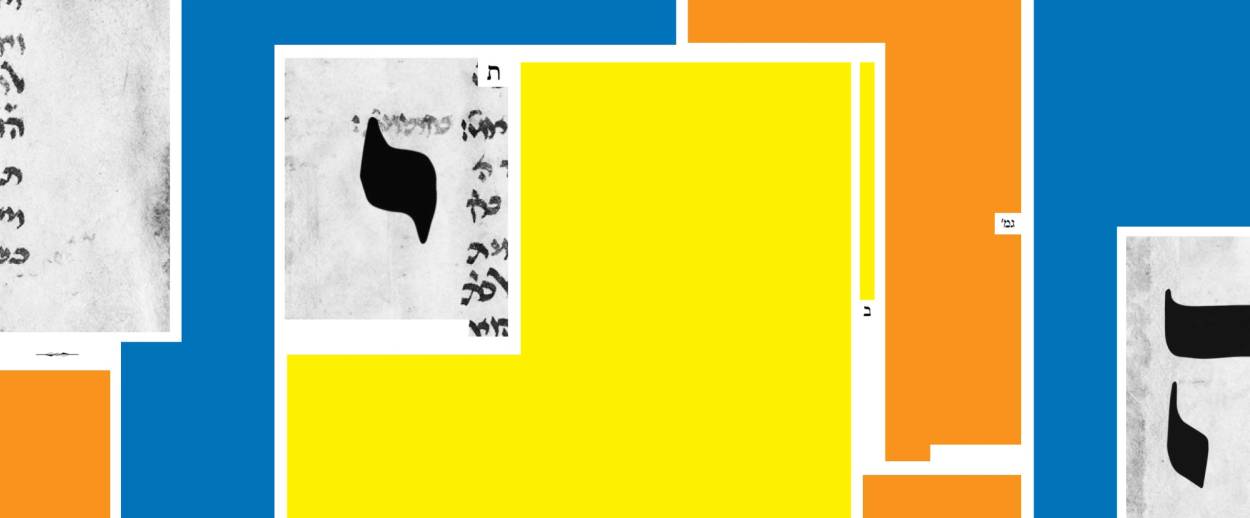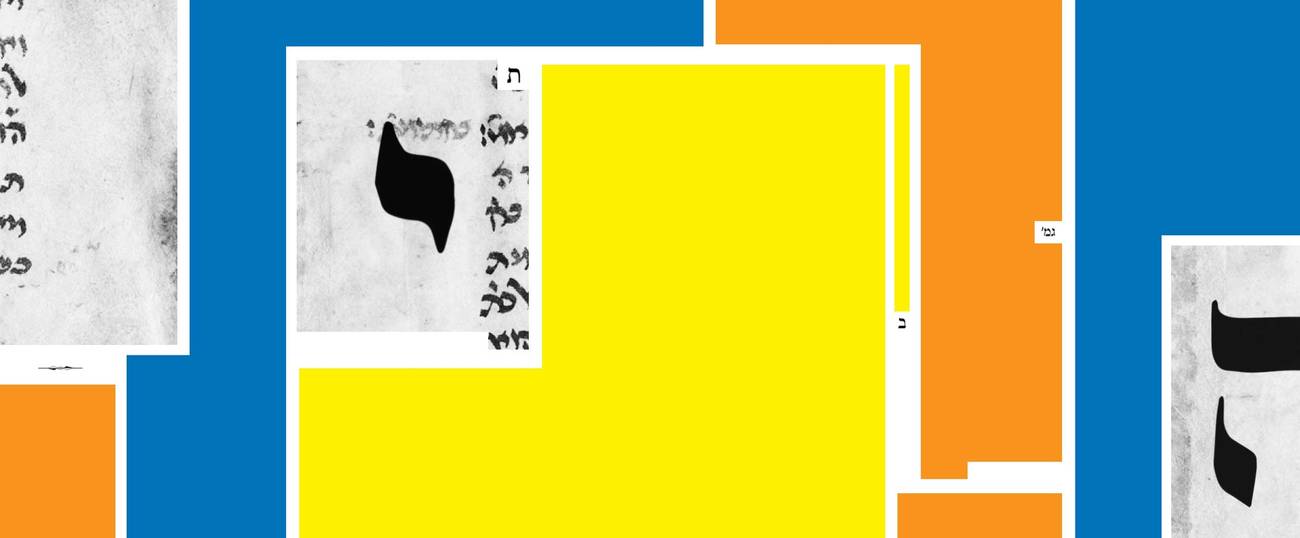Finding Meaning in Calligraphy
In this week’s ‘Daf Yomi’ Talmud study, why even the crowns of Hebrew letters matter. Plus: The biblical Moses is relegated to the eighth row of a rabbi’s class, for not understanding the lesson.




Literary critic Adam Kirsch is reading a page of Talmud a day, along with Jews around the world.
One of the pleasures of Daf Yomi is that you can never be sure what subject the next week will bring. The titles of the Talmudic tractates are only rough guides to their contents, and the rabbis’ discussions often go in unexpected directions. Thus Tractate Menachot, which we have been reading for the last month, is ostensibly about the meal offerings in the Temple; but last week’s reading was focused on the proper way to write Torah scrolls, mezuzot, and tefillin. Since these objects continue to play a central role in Judaism, while meal offerings do not, it is particularly interesting to learn about the reasons behind the very specific rules governing their production.
The transition from meal offerings to mezuzot is strictly formal. In meal offerings, as we have seen, a portion of meal is prepared and then the officiating priest removes a handful to burn on the altar; the remainder is assigned to the priests to eat. In Menachot 26a, we learn that both parts of the offering, the handful and the remainder, remain ritually connected even after they have been physically separated. Therefore, if the remainder of the meal becomes ritually impure after the handful has been removed, or is simply lost, Rabbi Yehoshua says that the handful, too, becomes unfit and cannot be sacrificed on the altar. Likewise, if the handful is deficient in some way—if it is too small, or offered with the left hand—the remainder cannot be consumed by the priests.
This principle—that a mitzva with two parts requires both parts to be performed correctly—is then applied to other, unrelated issues. In Menachot 28a, the mishna says that “With regard to the seven branches of the Candelabrum”—the sacred menorah in the Temple, whose construction is detailed in Exodus—“each prevents the fulfillment of the mitzva with the others.” That is, if one of the seven branches is missing, the others are disqualified from performing their ritual function. The same is true of “the two passages that are in the mezuzah”: A mezuzah must contain both the first and second paragraphs of the Shema to be ritually valid. Indeed, “even one letter prevents the fulfillment of the mitzva with the rest of them”: if a single letter in a mezuzah scroll is incorrect, the whole thing is invalid.
The Gemara begins by offering an extremely detailed description of the Temple menorah—which, of course, none of the rabbis of the Gemara had ever seen, since it was carried off to Rome as a trophy following the destruction of the Temple, and subsequently lost. (You can still see a record of this looting on the Arch of Titus in Rome, which shows the menorah being displayed as part of Titus’ triumphal march.) Nevertheless, building on the description of the menorah in Exodus and on oral tradition, they conjure a diagram of its ornaments, including “22 goblets, 11 knobs, and nine flowers.” Along the way, we learn that it is prohibited to make a replica of any part of the Temple or any of its sacred objects. That is why, to this day, Jews do not make seven-branched menorahs: “But one may fashion a candelabrum of five or six or eight branches,” the Gemara explains, such as the one used for the Hanukkah lights.
The Gemara goes on to give the most detailed rules for writing a Torah scroll that the Talmud has offered so far. When writing a Torah verse for a mezuzah, we learn, each letter must be perfectly formed. “Even the absence of the thorn of a yod” disqualifies the text. In addition, each letter must be separated from the next: “Any letter that is not encircled with blank parchment on all four of its sides is unfit.” And “seven letters require three crowns”: there are seven letters of the Hebrew alphabet that must be written with ornamental strokes or “crowns” on top.
One might think that these ornaments were dispensable, but a famous Talmudic story explains that they are essential. In Menachot 29b, Rav explains: “When Moses ascended on high, he found the Holy One, Blessed be He, sitting and tying crowns on the letters of the Torah. Moses said before God: Master of the Universe, who is preventing you from giving the Torah without these additions? God said to him: There is a man who is destined to be born after several generations, and Akiva ben Yosef is his name: He is destined to derive from each and every thorn of these crowns mounds upon mounds of halakhot.” It is a moving and powerful image, which says a great deal about how the rabbis thought about the Torah. Every single part of it, even the strokes of individual letters, are there for the purpose of teaching laws. The greatest rabbis are those who can find legal implications in the smallest details.
Indeed, the Gemara goes on to give a wonderful example of this ingenuity. Isaiah 26:4 reads, “for in the Lord [beYah] is God, an everlasting rock [tzur olamim].” The phrase tzur olamim can also be interpreted to mean “creator of worlds,” in which case the two Hebrew letters of the word Yah—yod and heh—refer to “the two worlds that the Holy One, Blessed be He, created.” But, Rabbi Yehuda bar Rabbi Elai goes on, how do we know which letter created this world and which the world to come?
The answer draws homiletic meaning from the very shape of the Hebrew letters. This world, the Gemara explains, was created with the letter heh, which is open on the bottom, giving it the form of a portico or open doorway. This teaches that “anyone who wishes to leave may leave”: That is, we all have the power to remove ourselves from life by sinning. “And what is the reason that the left leg of the letter heh is suspended”—that is, why is the leg not attached to the top vertical stroke, leaving a little gap between them? Because “if one repents, he is brought back in through the opening at the top.” And why does the letter have an ornamental crown on top? Because “The Holy One says: If a sinner returns, repenting for his sin, I tie a crown for him from above.”
This is the kind of interpretation that, in the Gemara’s story, left even Moses himself speechless. Indeed, the tale explains, God transported Moses to Akiva’s academy and allowed him to sit “in the eighth row”—that is, not in the first row, where the best Torah students were seated. This was fitting, for Moses could hardly understand the sophisticated interpretations that Akiva offered: “He did not understand what they were saying, and his strength waned.” But Moses was reassured when he heard Akiva explain that the halakha was “transmitted to Moses from Sinai.” This is a powerful parable of how Jewish tradition works: It evolves, often in ways that would have been incomprehensible to our ancestors, yet it remains the same thing. This combination of interpretative liberty and constraint is one of the hallmarks of the Talmud.
***
Adam Kirsch embarked on the Daf Yomi cycle of daily Talmud study in August 2012. To catch up on the complete archive, click here.
Adam Kirsch is a poet and literary critic, whose books include The People and the Books: 18 Classics of Jewish Literature.